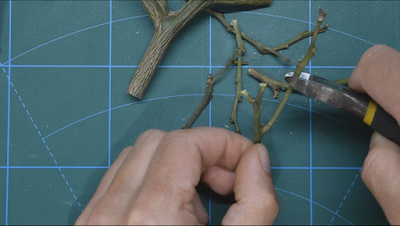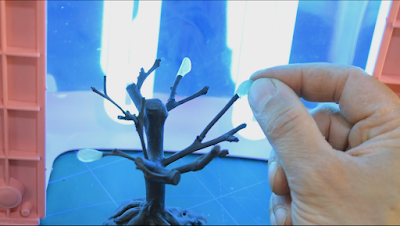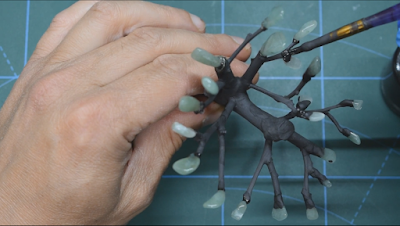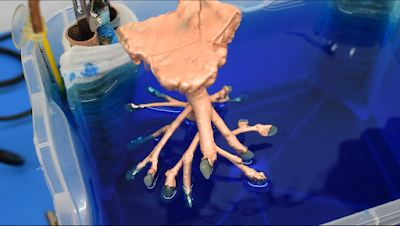May 16th is a day of love for nature and especially for trees. It is the “Hug a Tree” day and for the occasion I wanted to make a miniature tree made out of copper and I used Aventurine pebbles to resemble leaves.
Tools and material:
- some pruning from a tree
- a piece of cork
- CA Glue
- Apoxie Sculpt
- Disposable Gloves
- Conductive Paint --------> My recipe here
- Aventurine
- UV Resin
- Copper Wire
- Liver of Sulfur
- Nippers
- Bandsaw or a Hacksaw
- Rotary tool
- Round Burrs Bit
- Drill press or hand drill
- a drill bit of the diameter of the “trunk”
- Silicone tool brush
- Balled tool
- Brush
- UV Lamp
- Cotton swab
- All the electroforming supplies https://kit.co/cuforming/electroforming-advanced-kit
- Plastic Container
- Respirator Mask
- Radial Bristle Brush 600 grit
- Radial Bristle Brush 2000 grit
From the pruning I saved last time I cleaned my Lemon Tree, I choose a branch that looked perfect to be the trunk.
The nippers weren't strong enough to cut big parts, so I used my bandsaw to do the job.
Then I cut small parts to make other branches.
With a round burrs bit and my rotary tool, I made holes on the trunk to glue the branches. I tried to make it more organic possible. CA glue was the best choice to do this part.
For the base, I used a piece of cork that I found on the beach. I made a hole of the same diameter of the trunk with my drill press. In this case, I used a 10 mm bit.
After I glue them together it starts to take the shape of an actual tree, but it was not enough natural and then, with Apoxie Sculpt, I made some roots on the bottom.
I mixed the A and B parts with gloves because the two parts separated are toxic to be touched, but once they are combined, this putty is safe for the skin.
I made a few pointy sausages and put them all around the trunk.
With a silicon brush I made wrinkles and with a balled tool I try to make the Apoxie to stick better on the wood.
After 12 hours of drying, I dip the piece in my Conductive Paint. The container was too narrow for the tree top, so I had to use a brush for the missing spots.
To resemble leaves, I pulled out of my stash these Aventurine tumbled pebbles. This time I used UV resin to glue them on the branches. I know that UV resin is not very sticky on smooth surfaces, but I needed to be fast for all these leaves. They had to be on, long enough for the copper to secure them.
Anyway, it took me a while to glue all of them with the UV Lamp.
To repaint all the joints with Conductive paint I needed the same amount of time, but I finally manage to get it done.
With a cotton swab and a little solvent, I cleaned some smudges that I made on the stones.
I wrapped around the tree a piece of thin copper wire to hang it on the cathode rod of my tank and get it ready for the bath.
And the cork proved to be such due to its fame. It's floating! I had to add a stiff wire on it to keep it underwater. Start the power supply to the minimum current flow and leave to get coated in copper. I checked it every once in a while and when I saw that the cork part was completely covered in copper I change the position of the tree. Since it had a few spots uncoated, I crank up the current and let it be. Sadly the brightener fades off, so I had to add some more and, after not much longer, it starts to shine again, and I removed it from the tank.I washed off the tree all the electroforming solution residue and I put it in a container with water and a big amount of Liver of Sulfur because I wanted it to be black.
After an hour or so, I took it out and wash the residue.
I didn't toss all the yellow liquid in the sink this time because it was too much, so kept it in the same container with the lid on. But remember, every time you wanna get rid of Liver of Sulfur, you need to neutralize it with bleach.
Now I'm going to finish the tree with two bristle brushes. I put on my respiratory mask and start with the 600 grit to expose the copper on the trunk, roots, and branches.
I used the 2000 grit on the base to leave it black. This bristle is not as strong as the 600, so it will only make the black color to shine. I hope you will be enjoyed by this project. Watch the video I have on YouTube, and please subscribe for more tutorial like this one.
Thank you all. Cuforming.











































